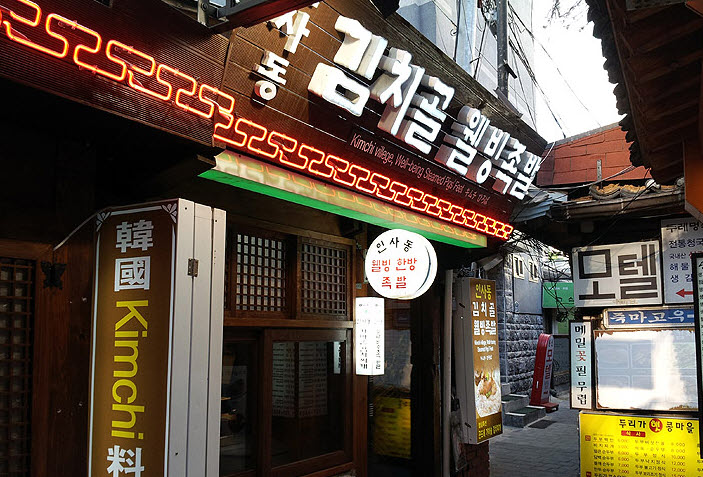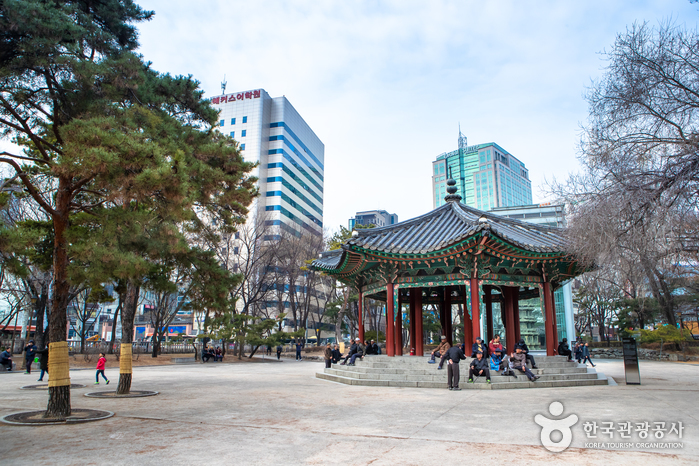Ssamzigil (쌈지길)
835.6M 2025-10-23
44 Insadong-gil, Jongno-gu, Seoul
Ssamzigil is an Insa-dong landmark and a shopping mall specializing in crafts. It is a place where the traditions of Korea come together with its present. Follow the paths that lead seamlessly from the lower floors to the upper floors and browse the small craft shops that inhabit the floors. You can find both works of traditional craft and contemporary craft here. Some craft shops also offer craft experiences, and one can also find restaurants and galleries within the complex.
Åland - Myeong-dong Main Branch [Tax Refund Shop] (에어랜드 명동본점)
835.2M 2024-06-27
40, Myeongdong 8-gil, Jung-gu, Seoul
-
Insa-dong Geujip (인사동그집)
836.4M 2024-03-18
3 Insadong 12-gil, Jongno-gu, Seoul
+82-2-737-0575
Insa-dong Geujip is a hanok-style Korean restaurant located in a narrow alley in Insa-dong. Their signature dish, bulgogi yachaemari (bulgogi and vegetable roll), allows you to choose between stir-fried pork bulgogi, beef bulgogi, or chicken bulgogi. Visitors can enjoy the tangy and sweet flavor of the radish wrap filled with bulgogi and julienned vegetables, accompanied by side dishes and soybean paste stew. They also offer bulgogi nakji jeongol (bulgogi and octopus hot pot), cheolpan sogalbijjim (stir-fried marinated galbi on hot iron plate), and dolsot bibimbap (hot stone pot bibimbap) along with hahu yukhoe bibimbap (Korean beef tartare bibimbap).
Kaist Optical Shop [Tax Refund Shop] (카이스트안경)
837.6M 2024-04-22
49, Myeongdong 2-gil, Jung-gu, Seoul
-
Davich Optical - Myeongdong Branch [Tax Refund Shop] (다비치안경 명동점)
840.5M 2024-06-27
62, Sogong-ro, Jung-gu, Seoul
-
Myeongdong Yeongyang Center (명동 영양센터)
843.8M 2024-03-11
52, Myeongdong 2-gil, Jung-gu, Seoul
+82-2-776-2015
Myeongdong Yeongyang Center specializes in roasted chicken and ginseng chicken soup. The jeongi gui tongdak (rotisserie chicken) is light and juicy with just the right amount of fat, and the crispy skin is excellent. The vinegar-marinated radishes are a must-have side dish. Samgye tang (ginseng chicken soup) is also the signature dish of the restaurant. The lunch special, Tongdak set menu (Roasted chicken set menu), features roasted chicken, chicken soup, nutritional bread, and vegetables, offering a satisfying ensemble.
Kimchigol Well-being Bapsang(김치골웰빙밥상)
843.0M 2024-10-14
22-5 Insadong-gil, Jongro-gu, Seoul
+82-2-720-6436
A restaurant where you can try kimchi, a Korean traditional dish, and meat. The representative menu is kimchi cabbage wraps with pork. This is a Korean cuisine located in Insa-dong, Seoul.
Tapgol Park (탑골공원)
846.6M 2024-03-04
99, Jong-ro, Jongno-gu, Seoul
+82-2-731-0534
Tapgol Park is the first modern park in Seoul. Having been the site of the Buddhist temple of Wongaksa Temple since 1467, the land was turned into a park in 1897. The park has a significant presence in Korean history, being the place where the March 1 Independence Movement began in 1919. One can find historical sites that hearken back to the struggle, such as the Palgakjeong Pavilion, the center of the movement; cultural heritage sites such as the Ten-story Stone Pagoda of Wongaksa Temple Site and the Stele for the Construction of Daewongaksa Temple at Wongaksa Temple Site; and monuments such as the independence movement relief plate, murals, the statue of Son Byeong-hee, and the statue of Han Yong-un.
The Saem - Myeong-dong Branch (No. 1) [Tax Refund Shop] (더샘 명동1호점)
846.7M 2024-04-16
41, Myeongdong 8-gil, Jung-gu, Seoul
-
![Åland - Myeong-dong Main Branch [Tax Refund Shop] (에어랜드 명동본점)](http://tong.visitkorea.or.kr/cms/resource/81/3314381_image2_1.jpg)

![Kaist Optical Shop [Tax Refund Shop] (카이스트안경)](http://tong.visitkorea.or.kr/cms/resource/47/2878647_image2_1.jpg)
![Davich Optical - Myeongdong Branch [Tax Refund Shop] (다비치안경 명동점)](http://tong.visitkorea.or.kr/cms/resource/98/2878598_image2_1.jpg)


 English
English
 한국어
한국어 日本語
日本語 中文(简体)
中文(简体) Deutsch
Deutsch Français
Français Español
Español Русский
Русский